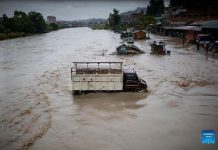
Deep Kiran Khadka lost his grandmother in the massive flash flood that struck Melamchi region in Sindhupalchowk district on 15th June. Not just grandmother, but his family also lost their home, farming land and the fish farm, which was their sole source of income.
Over a dozen either died or remained missing in the disaster, while many sustained injuries. The flood swept away houses and bridges, markets and roads, displacing over 1500 families and livelihoods.
Immediately after the disaster, the government agencies, national and international social organizations, relief providers, volunteers, researchers and hundreds of people visited the site and brought Melamchi in attention.
Khadka was hopeful that things would turn out good gradually for his family, and for others who lost their homes. Few months have passed, but the state of flood victims is still the same in the district, he explained.
“We had everything before the disaster, and now its in zero state. We don’t have home or land or anything left. It’s the concern of bread and butter. We feel ignored by the government, we are stateless like refugees,” Khadka expressed his disappointment.

The government provided Rs 30,000 as the relief to the families right after the disaster. Some international organizations allocated around 350,000 for the construction of a temporary shelter.
But Khadka and other families know that they can’t rebuild the house with that amount as they have to start from zero unlike the post 2015 earthquake scene. The families are not sure when they will get the support to build the new houses though they have been promised a relief of a half million.
“We are living at our uncle’s home since the disaster. The winter is getting extreme and zinc sheet cannot resist the temperature. We cannot sleep whole night. We should move to other locations soon, but we don’t know where to go…,” the young medical student shared, whose farm has turned into a barren land filled with sand and stones.
Displaced families in Chanaute Bazar in Melamchi are currently living either in temporary houses, huts or cow-sheds, on in any relative’s house. They worry that their state will be similar as of 2014 Jure landslide victims in the next 5 years, who are still struggling to start over their normal lives.
Every year, dozens lose their lives and are displaced in the monsoon season in Sindhupalchowk that has to withstand climate-included disasters like floods and landslides.
In 2014, a massive landslide struck Jure, where at least 170 households were displaced and 122 households lost their family members. Seven years after the disaster, many of these victims are still living in temporary shelters and waiting for the support from the government. Though there were talks on unified settlement since long time, locals doubt on the implementation part.
The Jure landslide was followed by earthquake of April 2015, which killed over 3500 people in Sindhupalchowk alone. The Bhotekoshi flood again snatched lives and properties in 2016, while the landslides continued every year. In the past seven years, there is not a single monsoon which hasn’t seen loss of lives, injuries or damages.

Regarding the latest Melamchi disaster, as per the detailed study done by ICIMOD, it was the result of multiple anthropogenic and climatic factors and processes that occurred at various locations along the Melamchi River.
According to experts, climate change is not the main and only reason for the disasters to happen, but it does play a role as a catalyst in the repetition of these disasters.
Manjeet Dhakal, a climate change expert, shared that these incidents will happen frequently, so need the necessary preparedness for those events, both extreme events and slow onset events.
“We need to set up an early warning system that will warn us about the upcoming disastrous events, so that necessary measures can be taken without the loss of anyone’s life or livelihood, ” he said, adding that “We need to make sure that there is a safe place for people who will need to be shifted from the site of disaster. ”
The country should plan all of this ahead, so that in times of disaster, people will not have to remain helpless, Dhakal suggested.
He further advised the authorities to continuously go through datas of the flow of rivers so that they will be able to assess the possibility of floods or drought beforehand.
Dr Rejina Maskey Byanju, Professor and Head of Department at Center of Environmental Science under Tribhuvan University is of view that one of the major causes for Sindhupalchowk district to be vulnerable is the development of infrastructures, which is done without any scientific research or reasoning, and urbanization.
“Scientific research is one of the best ways to prevent these disasters from happening again in the future. With those studies, we will be able to identify and prevent the disasters beforehand so that people and their livelihood will not be at risk,” Maskey remarked.
Meanwhile, National Disaster Risk Reduction and Management Authority is of view that the reasons behind the monsoon disasters cannot be confirmed right now, however, climate change is one of the reasons. Others include global destruction on the earth’s surface caused by the earthquake and constructions and infrastructure development done which has in turn put pressure in the vulnerable surface.
According to Dr. Dijan Bhattarai, spokesperson at the authority, during the time of disasters, they focus on giving immediate relief to the victims first and then work on reconstruction and resettlement.
The amount allocated for reconstruction of destroyed houses in the Himalayan region is 500,000, 400,000 in hilly region and 300,000 in Terai region. For people who have no roof above their head, a temporary place of living is built under the leadership of the District Disaster Management Committee.
For some places where houses cannot be reconstructed again because of the complexity, the government provides 300,000 to the family to buy land on other locations.
Beda Nidhi Khanal, Chief District Officer at Sindhupalchowk, accepts that everything has not been settled down yet. “We have started the work of reconstruction and resettlement. The construction of houses will start this winter in few places. We have the approximation that they will be able to live in their own house by the rainy season of 2022,” Khanal said.
He added that those whose homes were damaged are now living in the temporary shelters, with the relatives, or with the rent. “We have been looking for the places for resettlement. For now, people have received amounts for temporary housing. ”
Khanal said the authorities are accessing the safer area for resettlement and reconstruction that will have less effect from floods and landslides in the future, in the Melamchi and Helambu area.
Despite of the disasters occurring every year, he responded saying this is a very new kind of emergency in Melamchi, and “we are still accessing the framework of the district, in search of a safer place for living, as well as accessing and planning the reconstruction, and bringing in data on the possible risky areas near Melamchi.”
He noted that the district itself does not have the manpower or technology for those assessment, and since the authorities are also very new to this, the work is slow but is in progress.
Natural hazards are becoming more common in Nepal and in the Hindu Kush Himalaya region, demanding a more holistic approach in hazard assessment and risk management. But the state seems to be focused only during the period of disasters.
Anish Tiwari, a local journalist from Sindhupalchowk, who has closely followed the yearly disasters in the district, is of view that the government only makes commitments towards the disaster victims but fails to get into action.
“Immediately after any disaster, there are high level visits from the state level with big commitments, but they are never followed up. Same mistakes have been repeated. Its true that floods are not in control, but few landslides could have been prevented and managed,” Tiwari said.
Villages like Listi, Fulpingkoti, Karthali, Tripura, Gorthali and many others are still under risk, he shared. Years after the disasters, people are still living in the high-risk settlements waiting for the support from the state.
Recently, at least 1000 families have submitted a memorandum of understanding to the government demanding relocations but there has been no concrete response so far. “I am worried that the same incidents might repeat again…but the government is carefree,” he expressed sadness.








